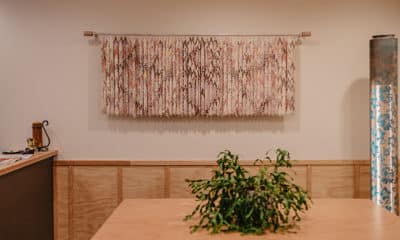SOMETIMES I WORRY that — in an effort to simplify and streamline – we’ve forgotten there are multiple ways to tackle the design and digital printing process. We often look at the limitations of a process or substrate as a dead end, but what if it’s a cue to be experimental and bold?
Recently, I’ve been working on some projects that have pushed me to reevaluate how and why I place significance on certain materials. For decades now, PSPs, designers, and color management experts have worked tirelessly to perfect color consistency, saturation, and clarity. They’ve achieved great results, which in turn, have allowed our industry to flourish globally across multiple markets. What happens then if your customer is looking for muted tones, vintage-inspired textures, or – dare I say it – glitchy, blurry prints? We need to be equipped to handle that, too.
That’s where the idea of “designing into fabric” comes into play. Let’s take dye sublimation textile printing, for instance. We all know this process is compatible with polyester fibers to achieve optimal results. That said, I’ve known a few risk-takers out there who have ventured into the less charted (and often unrecommended) territory of dye sub printing onto polyester blends –or even other synthetics such as nylon. In my experience, I’d say it’s probably best to steer clear of nylon, but when it comes to polyester blends we have a unique opportunity to innovate and capture a new creative style.
In the June/July issue, I wrote a piece, “From Start to Finish,” about emerging finishing processes for digital textile printing. If you read that piece, you’ll remember me illustrating processes like stone-washing or adding enzymes, which transforms the fabric in both look and texture from its pre-finished self. A similar metamorphosis can be executed onto polyester blends during the dye sublimation printing process. Want to emulate the worn and broken-in vintage look of your favorite college T-shirt? If you go the finishing route, you can break down the print by adding some enzymes or stone washing. Alternatively, if you go the other route, you can design into a polyester blend that will only accept a certain level of ink to achieve similar results.
Knowing how (or if) a fabric takes ink is key. Just because a polyester blend doesn’t achieve the same levels of ink saturation or consistency as a 100-percent polyester fabric, doesn’t mean it can’t be a top performer. You simply need to know your audience. The contemporary apparel market – and factions of the home décor market – are begging for this aesthetic.
When you’re working with designers in the apparel or home décor markets, in particular, embrace your ability to print this way on polyester blends. Show them how far you can push the polyester blends and encourage them to design into the “limitations” of the textile. I hope you’re realizing the limit does not exist – a muted way of printing is only a different way of printing and there’s a place for it in our catalogue of printing techniques, abilities, and offerings. Frankly, I’m waiting for a dye sublimation studio to pop up that specializes in custom, on-demand, vintage-style printing.
Advertisement
If there’s one thing I’ve learned, it’s that we have to continuously challenge ourselves to look at (potential) obstacles from every possible angle. If you’re new to the digital printing community, get ready to learn this lesson in new and different ways every day because there’s nothing stagnant about this technology. In the process we might even redefine the word “limitation” or eradicate it from our vocabulary altogether.


 Best of Wide Format2 months ago
Best of Wide Format2 months ago
 Best of Wide Format2 months ago
Best of Wide Format2 months ago
 Blue Print3 weeks ago
Blue Print3 weeks ago
 Best of Wide Format2 months ago
Best of Wide Format2 months ago
 Best of Wide Format2 months ago
Best of Wide Format2 months ago
 Best of Wide Format2 months ago
Best of Wide Format2 months ago
 Best of Wide Format2 months ago
Best of Wide Format2 months ago
 Best of Wide Format2 months ago
Best of Wide Format2 months ago





















